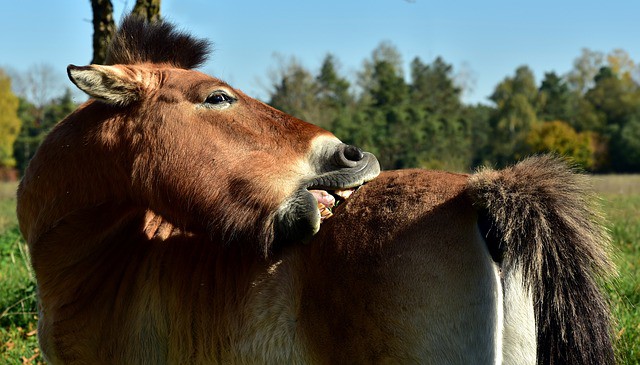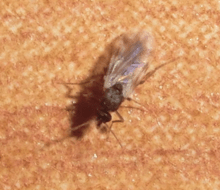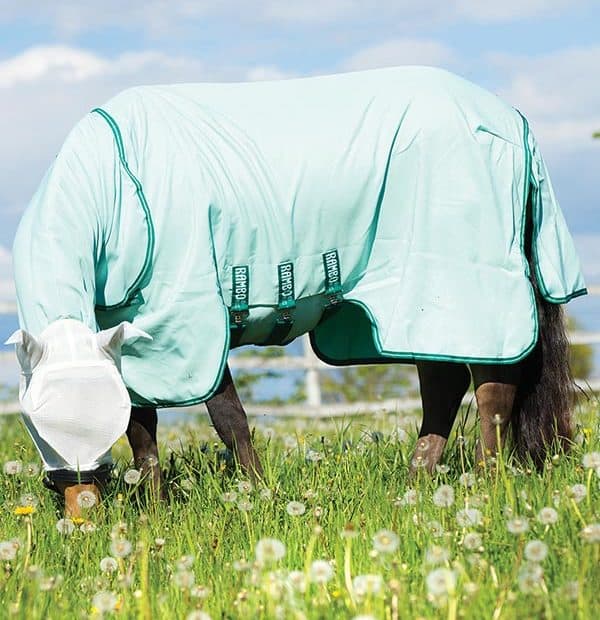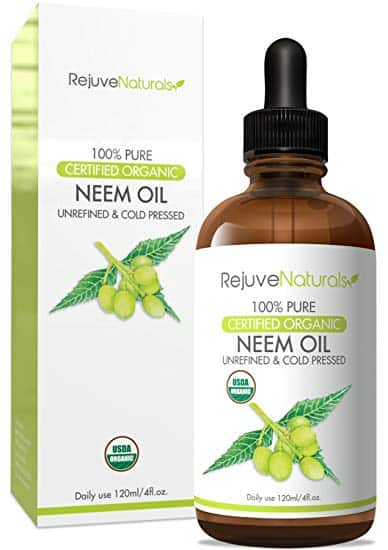Anyone who has had a horse with sweet itch knows how difficult it can be to keep it under control. If not minded the poor horse can be driven to rub and scratch so badly it not only removes the hair but large chunks of skin and tissue and your fencing!

So what causes it and why do some horses seem to suffer so badly in the summer and others not? More importantly what can we do with an affected horse to stop the scratching? Let’s face it, as much as it is a pain for the owner, it can’t be very pleasant for the poor horse either! I always think that the best way to cure a problem is to be armed with as much information about the cause as possible and this is true of sweet itch.
What Causes Sweet Itch?

Sweet itch is sometimes referred to as “Summer Seasonal Recurrent Dermatitis” (SSRD). It is caused by the Culicoides Midge that is mostly active during the late spring, summer and early autumn. These midges are most active at dawn and dusk, they breed in moist conditions in a variety of habitats, particularly damp, muddy areas and in manure and plant matter. Let’s face it who hasn’t seen the cloud hovering over the muck heap.
The adult midge can develop from egg, through lava and pupa, to adult in about a week during the summer and can over winter as a pupa to hatch when weather conditions are favourable. We often see them in a mild spell even in winter. However for that to happen the female midge needs a feed of blood to mature her eggs and this is why they bite.
When biting to feed they release saliva which contains proteins. These proteins are what cause the sweet itch prone horses immune system to react and start it scratching. In these horses the immune system mistakenly reacts to the foreign protein and an allergic reaction occurs. Where as in a non allergic horse the immune system reacts correctly and no itch occurs. Some studies have linked this to a hereditary trait.
It takes a few days for the horse to start showing symptoms. The severity of the reaction increases from year to year as the horses immune system becomes more sensitized to the midge saliva. Horses start to rub and scratch where the bites are. The most common midge targets the face and head, base of the mane, hind quarters and top of the tail. Others target the sides of the horse, belly, sheath or udder and inner thigh.

Because sweet itch can increase in severity it is not uncommon for a previously chronic low reaction to become acute. Especially if it is exposed to an environment where there are more midges. For example a horse moves from a breezy coastal location to an area which is more sheltered and surrounded by dense forestry and a pond of still water, or a horse changes yards to one where it is stabled in the shade near the muck heap.
Management of Sweet Itch.
So until a vaccine is developed how do we manage a susceptible horse? Well there are a few lines of defence we can take to protect the horse from exposure to the midge bites.

Housing.
- Ensure that the horse is stabled at peak midge activity times. This is mainly around dusk and dawn so the horse needs to come in overnight.
- Keep the stable bedding clean and dry. Stay away from deep litter which will encourage midges.
- Stable away from the muck heap; better still keep your muck heap away from the yard.
- Stable away from wash areas, drains and water taps where damp can encourage midges and try to eliminate areas of lying water such as puddles.
- If you have a choice of yard choose one that is not located near forestry, lakes and other water courses.
Grazing.
- Only allow grazing during day time when midges are less active. However pay attention to damp days when midges can also be active.
- Try to keep the horse off the grass until the dew has dried, midges can lay up in longer damp grass and be disturbed by the horse moving over it while grazing.
- Try to choose well drained land, being on marshy or bogy land won’t help.
- Keep ditches clear so water can flow away.
- Keep water tanks clean and filled with fresh water.
Rugs.
- Use a proper sweet itch rug and face guard to protect the horse 24/7.These have smaller holes than ordinary fly sheets and the best will cover the neck and wrap under the belly.
- Start using it before the horse starts to scratch. If you put it on once he is scratching it is likely to be several days before the itch has gone and the horse may have shredded the rug by then. If he is already scratching get corticosteroids or antihistamines from your vet to alleviate symptoms and put your rug on.
- Use your sweet itch rug even on wet days when a turn out rug may be needed, just keep it on underneath the turnout.

Pesticides (Not my favourite but…) and repellents.
- Products containing pyrethroid compounds can be useful but need to be applied regularly at higher application rates than for general fly kill.
- Benzyl benzoate has a duel action as a pesticide and repellent but cannot be applied to broken skin. It will irritate mucus membranes so do not get it near mares vulva or eyes. Remember it will still be on the hair after you have applied it so don’t rub your own eyes after touching the horse. Also its toxic to cats.
- Products containing DEET or Diethyltoluamide which is used in most Insect Repellents, when used as a repellent and can be effective if applied twice a day.
- Neem oil also has a duel action and is a naturally occurring oil. It has the benefit of encouraging hair growth, so it is useful if rubbing has already removed hair. It has anti inflammatory properties and contains vitamin E. NB**Use with caution, Neem Oil should not be used if you are pregnant or breastfeeding, or on a mare who is pregnant or lactating.

- In general to be effective these products need to be rubbed down to the skin not just on the hair.
- There are a huge number of specialist products targeted at alleviating the traumas of sweet itch, most are a combination of repellents and insecticides and often contain natural ingredients. Be warned many homeopathic ingredients can cause reactions on a horse’s skin so always test them on a small area and check to see if a reaction occurs. These would include things like eucalyptus, tea tree and citronella, generally their effect is quite short lived.
- Oils such as baby oil or coconut oil can create an effective barrier as the midges tend to avoid it. Again only effective if applied regularly. NB** If using oils be careful of very hot sun as you don’t want to fry your horse!
Feed supplements.
- For a long time the feeding of garlic was used as a feed supplement to aid in combating sweet itch by boosting the immune system. However as we now understand more about the way the horses immune system reacts to the midge bite it is not recommended as it may have the opposite effect.

- Omega 3 fatty acids can help to reduce skin inflammation and lessen allergic reactions. Some of the better sources include fish oils, linseed and chia seed oil as these have a better balance of omega 3 to omega 6 in them.
It is still necessary to declare a horse as having Sweet Itch at point of sale. When being vetted a veterinary surgeon would have to mention if there was evidence of the condition. If a horse developed the condition subsequently it would be difficult to establish if it was sold knowingly with the condition. Whilst the predisposition to develop sweet itch was always there, the horse’s previous regime may have limited its exposure to midges and the horse may have had little or no reaction. The horse may have developed the signs due to a natural increased progression in sensitivity or a sudden exposure to more bites in its new environment.
At the end of the day we still have no cure for sweet itch, however with proper care and preventative measures it can be managed.
This Article was originally published in our June 2019 Edition of Irish Sport Horse Magazine. Jessica Soley BHSI is a Level 5 Performance Coach and Senior Assessor for The British Horse Society. Having Competed and Run her own Competition Yard she is now an Equine Tutor for the QQI Equine Courses at level 5 & 6, run by KWETB in Kildare.
